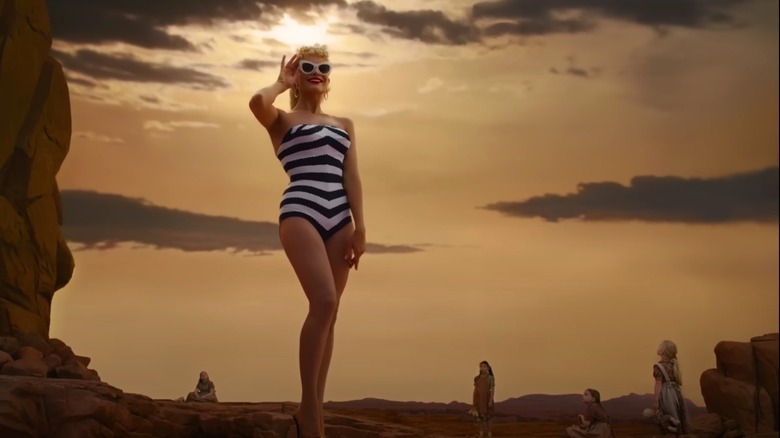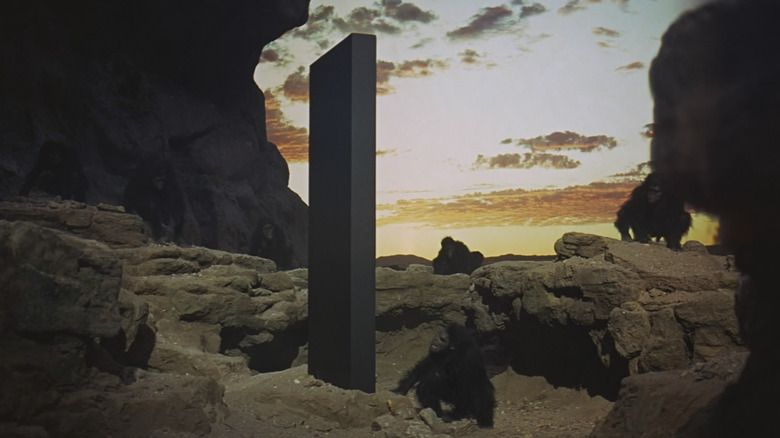Barbie's Marketing Team Had Concerns Over Its 2001: A Space Odyssey Parody
The opening scenes of Greta Gerwig's blockbuster "Barbie" feature multiple young girls, each of them dressed in drab, mid-'50s frocks, playing with baby dolls. A narrator (Helen Mirren) notes, prior to 1959, babies were the only doll option for kids, implying that little girls were being trained for their eventual expected role as housewives and mothers. Surreally, the girls are playing out in a vast, prehistorical desert, with no homes or parents anywhere to be seen.
Then, she appears.
Standing about 15-feet tall, Barbie (Margot Robbie) manifests in the dirt nearby. She stands there, statuesque, presenting the young girls with the next step in their playtime evolution. Baby dolls are instantly a thing of the past. Barbie, an adult doll, is now going to be the girls' whole world. The girls wander in idle awe up to Barbie, touching her leg, making sure she's real. One of the girls begins dramatically smashing her baby doll on the rocks, filled with wrath that she was ever forced to play with such a trifling object. She throws the baby into the air. In a hard cut, the discarded baby becomes the film's title card.
It doesn't take a very sophisticated cineaste to see Gerwig's re-staging of several key moments from Stanley Kubrick's 1968 classic "2001: A Space Odyssey." Gerwig merely replaced Kubrick's protohumans with young girls, the mysterious evolution-sparking black monolith with Barbie, and the protohumans' weaponized tapir bone with a hurled babydoll.
"2001" is hardly oblique to most adult audiences, but according to a recent interview with Variety, Josh Goldstine, Warner Bros.' president of global marketing, felt that it might be too obscure for some of the younger kids in the audience.
Barbie, Barbie, Give Me Your Answer, Do
While "2001: A Space Odyssey" might have been made in 1968 — many decades before the 13-year-old target audience of "Barbie" was born — its iconography has permeated cinema culture ever since its release. The film still screens regularly at repertory houses all over the world, and its images have been referenced and parodied countless times. One might recall Homer Simpson becoming the Star Child, Zoolander and Hansel hitting an iMac computer like apes, or a bunch of grunting, furry ape-men from Mel Brooks' "History of the World, Part I." HAL was envisioned as a jealous lover on "Futurama," and the obelisk was turned into a soda machine in a spoofy opening for the animated series "The Critic." And who could forget Allan A. Goldstein's"2001: A Space Travesty" from 2000? Apart from everyone?
Still, Josh Goldstine was a little apprehensive at first that kids wouldn't get the reference. Ultimately, he included the "2001" spoof in the "Barbie" marketing campaign, as he felt it was unlike ad campaigns that came before it, and he was eager to be pioneering. When asked if the reference might go over kids' heads, Goldstine said:
"Yes, that was absolutely a concern. We wanted to challenge people. We wanted to make something thought-provoking. People had preconceptions. We thought that, by shaking them, we could create a tremendous amount of curiosity."
Goldstine's instincts were correct. The "2001" reference absolutely worked and played into a winking irony surrounding the movie. If "Barbie" thinks it's as large and as important as "2001," there must be something notable about it. But then, when the giant, obelisk-sized Barbie pulled down her sunglasses and literally winked, a little air of "just joshin' ya" became part of the tone. This was going to be a comedically self-effacing film.
The campaign must have worked. "Barbie" has earned $1.38 billion to date.

